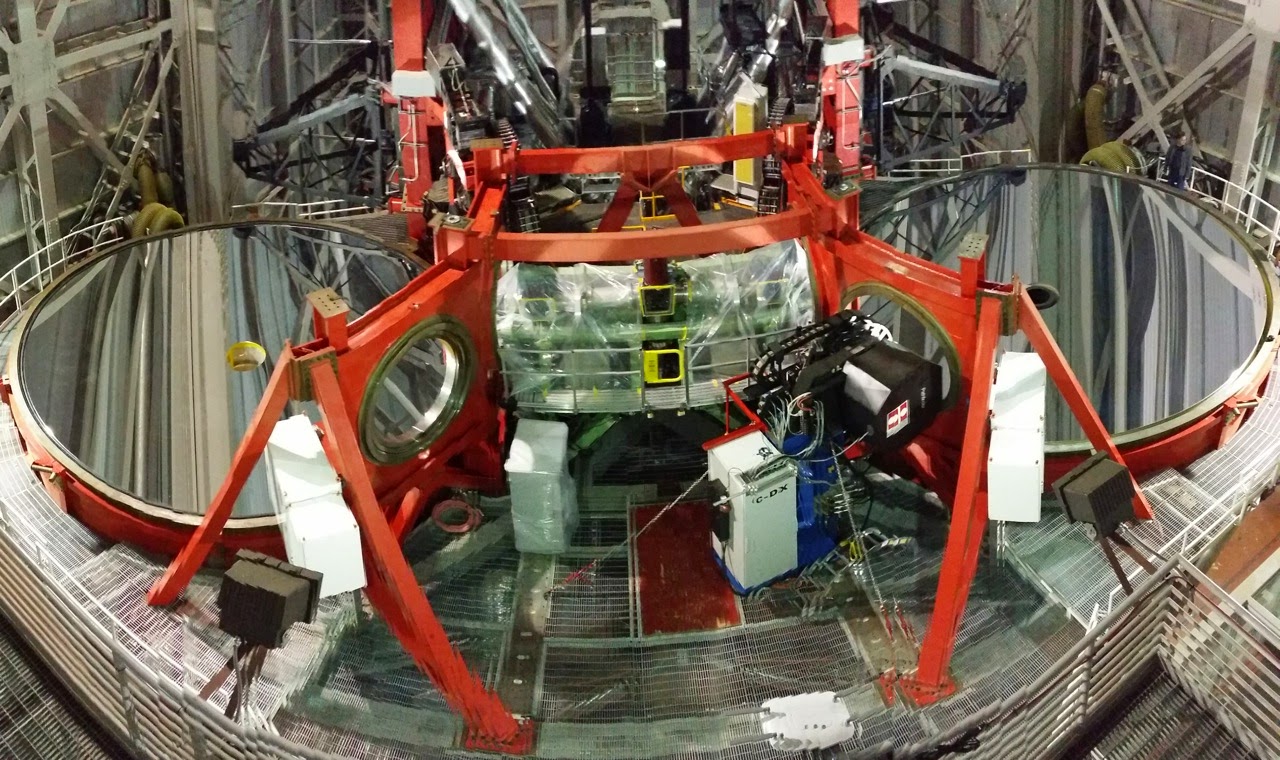Every summer, during monsoon season, the observatory is shutting down to perform a mix of maintenance tasks and improvement/development work which all require the telescope to be inoperative for an extended period of time, therefore precluding any observation.With short nights and the weather in average much worse than during the rest of the year, July/August is the preferred time.
The 2014 shutdown lasted from July 9 to August 29 and the observatory is now in restarting mode for a couple of weeks. Science will start again on September 17 (see the 14B schedule
here).
On the long list of things to do during shutdown, taking care of our two primary mirrors remains a big endeavor. Every year, we realuminize one of them and wash the other. As there are no mirror covers (yet), the main mirrors are more exposed to an environment which is not very forgiving (moths, pollen, dust, ...) than at other observatories. This year, the right mirror (DX) got a new coating and the left (SX) went through a good cleaning.
 |
| Washing DX before stripping the aluminum (Jul 28) |
 |
| The DX main mirror is now ready for aluminizing (Jul 29) |
 |
| Washing SX (Aug 20) |
 |
| The telescope has now two clean eyes! |
The realuminizing went went very smoothly and the coating on DX is one of the best so far. SX is clean and shiny. As the moth population is smaller than usual this summer, both should stay clean for quite some time. You can see pictures of other phases of the realuminizing process
here (2013 shutdown).
Much work has been done on various subsystems of the telescope. To cite only a few: improvement of mirror ventilation and instrument cooling system, installation of new oil catchment, roof sealing, addition of flexible vacuum lines for LINC NIRVANA, maintenance and improvement of AGW (Acquisition, Guiding, and Wavefront sensing units) #1 and #2, including the addition of a tip-tilt sensor for ARGOS on AGW2 (right side), ...
 |
| Preparing for on-site fitting of the newly built oil pans |
 |
| Oil pans are now installed under the C-rings |
 |
| Working on one of the many cooling systems on level 4 , under the telescope level of the enclosure |
 |
| The two shiny hoses hanging from the telescope structure to the enclosure wall will be used by LINC NIRVANA to cool down their detectors. |
On the instrument side, the LBCs went through their annual maintenance. LUCI1, which had been unavailable due to various issues for a good part of last semester, was brought back to life and the tests so far have not shown any problem. Work on
PEPSI by the IAP team continued and we should be able to announce soon the first light from the
VATT through an optical fiber laid underground between the two observatories. Stay tuned!
A last note: The shutdown started with a couple of heavy hailfalls, which resulted in hail clogging the water drains, immediately followed by heavy rains and water finding its way through the door seals on top of the enclosure, ending on the telescope. Damage was limited, but unfortunately, the oil used for the hydrostatic bearings on which the mount rides (both in azimuth and elevation) was contaminated by water. So, instead of moving right away to the usual shutdown activities, some of our staff had to take care of purging the whole oil system, cleaning up before replenishing it with fresh oil. Fortunately, we were able to clean the contaminated oil at base camp and to use it again.
 |
| Water on one of the mirrors after the hail storm. Not a welcome start for a shutdown, but at least the mirrors were going to be washed or realuminized! |
The source of the flooding has been identified and corrective action will be taken as soon as possible.












.jpg)








